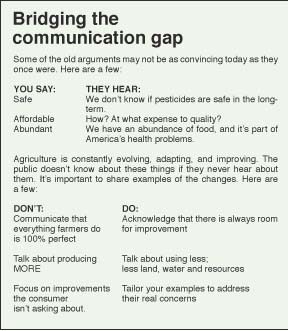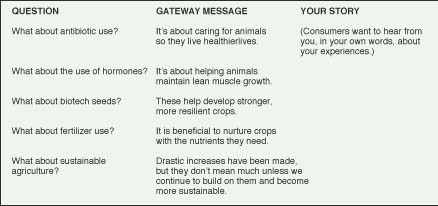Most of us have seen footage and photographs of alleged animal cruelty on farms. These images leave a bad impression of agriculture in the minds of many, and do nothing to promote all the positive things there are to say about agriculture.
It’s no surprise the public has become more concerned about food animal production, how animals are raised, and what treatments have been given to animals.
The interest in farmers markets and grocery stores such as Whole Foods are popular with consumers because they provide not just food, but food that is perceived to be fresher, better tasting, and healthier.
Those locations also provide a social time for consumers to interact with growers or other consumers.
Positive foundation
The public, for the most part, has a positive attitude and respect for farmers. They just want to know more about their food and the people who produce it. Agriculture is doing a better job of telling its story, but there is always room for improvement.
It’s easy to say that someone else should do the education, and Extension, Farm Bureau, private industry and others do so, but it means even more when the public can hear a farmer describe what he or she does, why it’s important to the consumer, and the benefits they receive.
Recently I attended a livestock quality assurance in-service. Dr. Paul Kuber, OSU Extension specialist in animal science, discussed the many resources developed by Ohio State University Extension, the Ohio Department of Agriculture, and a program developed by the U.S. Farmers and Ranchers Alliance (USFRA) called Conversations with EASE. EASE is an acronym for Engage, Acknowledge, Share, and Earn Trust.
Getting started
Starting the conversation and engaging people is the first step. Here are a few examples of how you can.
- If you are fortunate enough to jump on a plane for a vacation (I know many of you are may be thinking that will not happen) and sit with someone you don’t know, begin the conversation.
- If you are at the grocery and see someone trying to make a decision about what dairy product to purchase, introduce yourself as a dairy farmer. You might be able to answer their question, and provide some education.
- Visit a farmers market. You can go as a vendor or just to observe. There opportunities to talk with consumers and teach them about agriculture.
Their viewpoint
Understand that consumers have questions and concerns, even if they are not the same as your own.
Consumers aren’t necessarily criticizing farmers. Much of the population today is far removed from production agriculture and they are simply trying to learn more about the process.
Earn trust
This whole thing is about trust.
When you hear something from someone you don’t trust, do you believe what they say? Probably not. The same thing is true with conversations about agriculture.

The U.S. Farmers and Ranchers Alliance advocates having an approach rather than a message. This approach welcomes all points of view. It also realizes that listening to others and sharing stories about agriculture around continuous improvement are the pillars of USFRA’s approach.
Research shows there are persistent questions being asked by consumers. A conversation rather than a debate about whose beliefs or facts are right can help farmers and consumers understand one another.
The USFRA presented findings of a study conducted to answer: To the extent you have concerns about the methods conventional farmers and ranchers use, what concerns you most?
- Unintended long-term health effects 37%
- Poor treatment of animals 23%
- Environmental harm 12%
- Unintended short-term health effects 11%
- None of these really concerns me 17%
The USFRA believes there are gateway messages that create a productive conversation in which understanding can be achieved. Gateway messages provide a starting point to discuss food production in a meaningful way with consumers.
Think of the gateway message literally as a gate you pass through to have a conversation about your farm and what you do to produce healthy food.
- Acknowledge concerns with an open-mind: Concerns are real. They are not right or wrong. You don’t have to agree, but acknowledge concerns exist. Examples: “I understand your concern…” “I can see why you feel that way…” “A lot of people have that same question…”
- Talk about what concerns consumers — not what you want to talk about: Agriculture needs to know more about what they’re asking, so we can know how to answer them.
- Don’t refute the facts alone: Addressing a concern with a refuting set of facts just dismisses the concern and does nothing to open a conversation. The goal is to achieve understanding about each other.
- Turn off your defense: It’s about the food we eat, not the people who grow it. Always approach every conversation as an opportunity to share the story of the great things happening in agriculture and on your farm.
- Don’t claim to be 100 percent right: Who is? Share the story of what you have done and how you have improved.
- Talk about using less instead of producing more: Agriculture today uses fewer resources and still produces healthy food.
Your turn
Agriculture has made improvements in telling its story, and there are many opportunities to continue this process. Consider using some of the suggestions offered here to begin a conversation with someone who has questions about agriculture.
Will you change the attitudes and opinions of each person you talk with? Of course not, but you made an attempt, and maybe learned something from them along the way.













